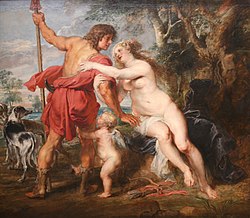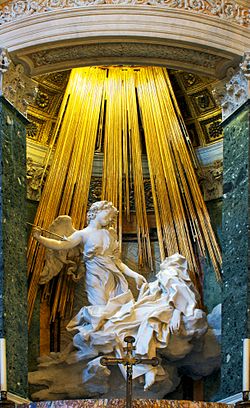
Baroque
Artistic style in Europe and colonies, c. 1600–1750 / From Wikipedia, the free encyclopedia
Dear Wikiwand AI, let's keep it short by simply answering these key questions:
Can you list the top facts and stats about Baroque?
Summarize this article for a 10 years old
The Baroque (UK: /bəˈrɒk/, US: /-ˈroʊk/; French: [baʁɔk]) or Baroquism[1] is a style of architecture, music, dance, painting, sculpture, poetry, and other arts that flourished in Europe from the early 17th century until the 1750s.[2] It followed Renaissance art and Mannerism and preceded the Rococo (in the past often referred to as "late Baroque") and Neoclassical styles. It was encouraged by the Catholic Church as a means to counter the simplicity and austerity of Protestant architecture, art, and music, though Lutheran Baroque art developed in parts of Europe as well.[3]
Top: Venus and Adonis by Peter Paul Rubens (1635–1640); centre: The Ecstasy of Saint Teresa by Bernini (1651); bottom: the Palace of Versailles in France (c. 1660–1715) | |
| Years active | 17th–18th centuries |
|---|---|
The Baroque style used contrast, movement, exuberant detail, deep colour, grandeur, and surprise to achieve a sense of awe. The style began at the start of the 17th century in Rome, then spread rapidly to the rest of Italy, France, Spain and Portugal, then to Austria, southern Germany, and Poland. By the 1730s, it had evolved into an even more flamboyant style, called rocaille or Rococo, which appeared in France and Central Europe until the mid to late 18th century. In the territories of the Spanish and Portuguese Empires including the Iberian Peninsula it continued, together with new styles, until the first decade of the 19th century.
In the decorative arts, the style employs plentiful and intricate ornamentation. The departure from Renaissance classicism has its own ways in each country. But a general feature is that everywhere the starting point is the ornamental elements introduced by the Renaissance. The classical repertoire is crowded, dense, overlapping, loaded, in order to provoke shock effects. New motifs introduced by Baroque are: the cartouche, trophies and weapons, baskets of fruit or flowers, and others, made in marquetry, stucco, or carved.[4]


